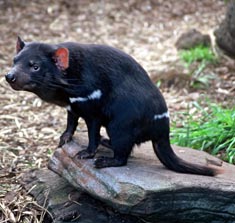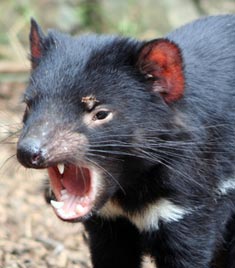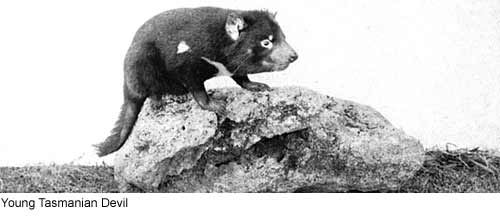|

Just the Facts: The Tasmanian Devil is characterized by its black fur, offensive odor when stressed, extremely loud and disturbing screech, and viciousness when feeding. It is known to both hunt prey and scavenge carrion and although it is usually solitary, it sometimes eats with other devils.
 Uncanny Carnivor: The Tasmanian Devil is the largest surviving carnivorous marsupial in Australia. It has a squat and thick build, with a large head and a short, stubby tail. The devil stores body fat in its tail and an unhealthy devil often has a thin tail. Uncanny Carnivor: The Tasmanian Devil is the largest surviving carnivorous marsupial in Australia. It has a squat and thick build, with a large head and a short, stubby tail. The devil stores body fat in its tail and an unhealthy devil often has a thin tail.
Weights and Measures: Unusually for a marsupial, its forelegs are slightly longer than its hind legs. Devils can run in bursts at the impressive speed of 13 kilometers per hour (8.1 miles per hour). The fur is usually black, although irregular white patches on the chest and rump are common. Males are usually larger than females, having an average head and body length of 652 mm, with a 258 mm tail, and an average weight of 8 kg. Females have an average head and body length of 570 mm, with a 244 mm tail, and an average weight of 6 kg. The average life expectancy of a Tasmanian Devil in the wild is estimated at six years, although it may live longer in captivity.
Devil's Whiskers: The devil has long whiskers on its face and in clumps on the top of the head. These help the devil locate prey when foraging in the dark, and aid in detecting the closeness of other devils during feeding.
 Sight, Hearing, Smell, Bite: When agitated, the devil can produce a strong odor, its pungency rivaling even the skunk. Hearing is its dominant sense, and it also has an excellent sense of smell. Since devils hunt at night, their vision seems to be strongest in black and white. In these conditions they can detect moving objects readily, but have difficulty seeing stationary objects. Sight, Hearing, Smell, Bite: When agitated, the devil can produce a strong odor, its pungency rivaling even the skunk. Hearing is its dominant sense, and it also has an excellent sense of smell. Since devils hunt at night, their vision seems to be strongest in black and white. In these conditions they can detect moving objects readily, but have difficulty seeing stationary objects.
An analysis of mammalian bite force, corrected for body size, shows that the devil has the strongest bite of any living mammal. The power of the jaw is in part due to its comparatively large head. A Tasmanian Devil also has one set of teeth that grows slowly throughout its life.
Tons in Tasmania: Tasmanian Devils are widespread and fairly common throughout Tasmania. Found in all habitats on the island, including the outskirts of urban areas, they particularly like dry forests and coastal woodlands. The Tasmanian Devil is a nocturnal and crepuscular hunter, spending the days in dense bush or in a hole.
Marsupial Athletes: Young devils can climb trees, but this becomes more difficult as they grow larger. Devils can also swim. They are predominantly solitary animals and do not form packs. They occupy territories of 8–20 km², which can overlap considerably amongst different animals.
What's for dinner? Tasmanian Devils can take prey up to the size of a small wallaby, but in practice they are opportunistic and eat carrion more often than they hunt live prey. Although the devil favors wombats, it will eat all small native mammals, domestic mammals (including sheep), birds, fish, insects, frogs and reptiles. Their diet is largely varied and depends on the food available. On average, they eat about 15% of their body weight each day; however, they can eat up to 40% of their body weight in 30 minutes if the opportunity arises. Tasmanian Devils eliminate all traces of a carcass, devouring the bones and fur in addition to the meat and internal organs. In this respect, the devil has earned the gratitude of Tasmanian farmers, as the speed at which they clean a carcass helps prevent the spread of insects that might otherwise harm livestock.
 Dinner Party: Eating is a social event for the Tasmanian Devil, and much of the noise attributed to the animal is a result of raucous communal eating, at which up to 12 individuals can gather and which can often be heard several kilometers away. Dinner Party: Eating is a social event for the Tasmanian Devil, and much of the noise attributed to the animal is a result of raucous communal eating, at which up to 12 individuals can gather and which can often be heard several kilometers away.
A study of feeding devils identified 20 physical postures, including their characteristic vicious yawn, and 11 different vocal sounds that devils use to communicate as they feed. They usually establish dominance by sound and physical posturing, although fighting does occur. Adult males are the most aggressive, and scarring is common from fighting over food and mates.

Birds and Bees: Females start to breed when they reach sexual maturity, typically in their second year. At this point, they become fertile once a year, producing multiple ova while in heat. Mating occurs in March, in sheltered locations during both day and night. Males fight over females in the breeding season, and female devils will mate with the dominant male. Devils are not monogamous, and females will mate with several males if not guarded after mating.
Babies Galore: Gestation lasts 31 days, and devils give birth to 20–30 young, each weighing approximately 0.18–0.24 grams. When the young are born, they move from the vagina to the pouch. Once inside the pouch, they each remain attached to a nipple for the next 100 days. The female Tasmanian Devil's pouch, like that of the wombat, opens to the rear, so it is physically difficult for the female to interact with young inside the pouch. Despite the large litter at birth, the female has only four nipples, so that no more than four young can survive birth. On average, more females survive than males. Those who do not procure a nipple are typically eaten by the mother.
They grow op so fast! Inside the pouch, the nourished young develop quickly. At 15 days the external parts of the ear are visible. Eyelids are apparent at 16 days, whiskers at 17 days, and the lips at 20 days. The young start to grow fur at 49 days and have a full coat by 90 days. Their eyes open shortly after their fur coat develops—between 87 and 93 days—and their mouths can relax their hold of the nipple at 100 days. They leave the pouch 105 days after birth, appearing as small copies of the parent and weighing approximately 200 grams. Unlike kangaroo joeys, young devils do not return to the pouch; instead, they remain in the den for another three months, first venturing outside the den between October and December before becoming independent in January. Female devils are occupied with raising their young for all but approximately six weeks of the year.

All text is available under the terms
of the GNU Free Documentation License
|